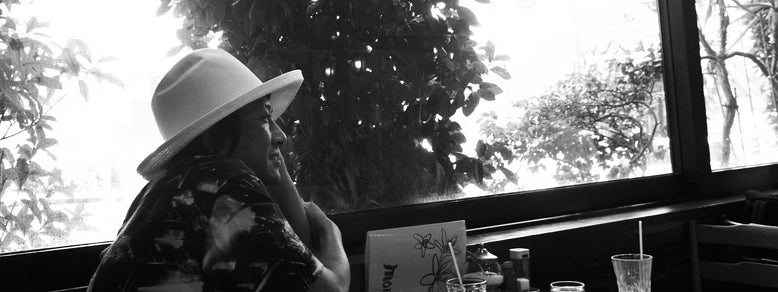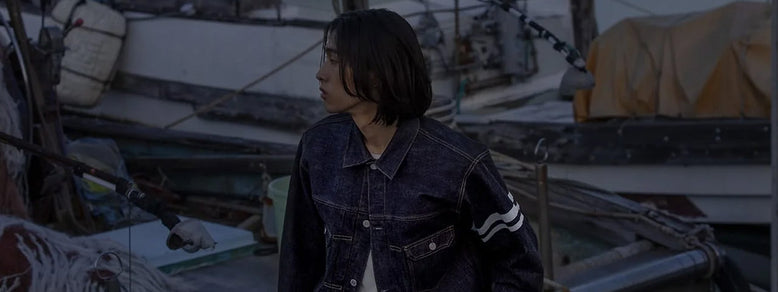Driven by the Blue of Memory
Keisuke Nagoshi’s Journey Continues
Boarding trains crossing barren landscapes, wandering through deserts, stepping into slums that even locals avoid, Keisuke Nagoshi is a photographer who has documented the daily lives of extraordinary communities of people with ways of life one hardly ever sees. His recent photo story on MOMOTARO JEANS captures his visit to Kojima, Okayama― where the deep blue of denim both blends in and contrasts with the seaside town at dawn. Here, Nagoshi shares why he chose to press the shutter.
PHOTOGRAPH : Yusuke Abe(YARD)
EDIT & TEXT : Rui Konno
The Unexpected Similarities Between Okayama and the Sahara

―I’d like to start by asking how you came to shoot the new visuals for MOMOTARO JEANS.
Nagoshi: I had a photo exhibition in Tokyo a while back and Kaie Murakami, who’s involved in MOMOTARO JEANS’ rebranding, came to see it. It featured photographs I’d taken during my time with the Tuareg people― nomads who are living in the Sahara Desert. I think that’s where it started. We’d been talking about working together for a while, and then he proposed, “How about doing a shoot in Kojima?”
―Did you have any prior connection to Kojima?
Nagoshi: My parents are from Okayama, and they still live there, so I’ve had plenty of chances to visit the prefecture itself. But I’d never been to the seaside. My parents live deep in the mountains, really close to the peak. So it felt really new to me. I’ve never lived there, but since Okayama is part of my roots, I was able to see it from different angles.
―I see.
Nagoshi: After my father and brother passed away, I wanted to better understand my father’s origins, so I spent some time in Okayama following in his footsteps. I can’t say for certain, but during that time I felt something deeply mysterious and profound about Japan. For this shoot, I tried to tap into those feelings again.
―What was Okayama like, objectively speaking?
Nagoshi: It reminded me of a Seishi Yokomizo novel. The setting in The Village of Eight Graves is actually close to where my parents live. My father used to tell me stories about sword-making in Shimane, or the clay for Bizen pottery. But those were all just about the mountains. For this shoot, I spent two days on the coast. Over dinner one night with some locals, I learned that Kojima was developed through the absorbing of cultural influences from different regions. That struck a chord. We also shot at the Nozaki Residence, built by a family who made their fortune through salt. That’s when I made the connection to the Tuareg.
Photographer_Keisuke Nagoshi (um tokyo)
Stylist_Keisuke Shibahara
Hair & Make-up_Yoshikazu Miyamoto (BE NATURAL)
Creative Director_Kaie Murakami (SIMONE)
Art Director_Naoki Mizobe (SIMONE)
Designer_Yuuri Fujii (SIMONE)
Movie Director_Ayano Kamiyama (SIMONE)
Business Producer_Haruka Hirano (SIMONE)
Production Manager_Marin Kanda (SIMONE), Yuko Igarashi (SIMONE)
Model_KOHEI
KENYA (TOMORROW TOKYO)
KINARI (Image)


―From salt?
Nagoshi: Well Tuareg people also spend a lot of time traveling across the desert to carry and sell salt. They also wear blue garments dyed with natural indigo. I felt there was a strangely close parallel between the two, even if it was just a coincidence.
―That is an interesting coincidence, but why did you want to photograph the Tuareg people in the first place?
Nagoshi: For about 20 years, I’d been wanting to go to a music festival held in the desert of Mali. I especially wanted to see Tinariwen, a Tuareg music artist group who’ve won a Grammy and are known as the “Desert Blues.” Through their music, I became fascinated with the Tuareg people themselves and wanted to meet them. But the civil war there was so intense that I couldn’t go for a long time. Then, by chance, a route opened up through Algeria at just the right time.
Blue as a Versatile Symbol
―What kind of people are the Tuareg?
Nagoshi: They are nomads, but with a revolutionary spirit who’ve been fighting to reclaim their territory. Most of them live in settled communities now, but I could still see traces of their traditional nomadic life. Blue holds special significance for them, as it’s a symbol of wealth. There’s even a color known as ‘Tuareg blue,’ which is an intensely deep shade of indigo.
―So blue holds special meaning for them too.
Nagoshi: I think so. But in America, blue carries strong associations with labor. In the 1910s for example, there was “train hopping.” People would jump freight trains and travel around mining for gold. Their work clothes were blue too.
―It’s fascinating how blue means different things depending on where you are. In your photographs, what role does blue play?
Nagoshi: In my mind, it represents freedom, which is probably why blue features so prominently in my work. This MOMOTARO JEANS project was no different. In the final images, that deep blue that comes out from the slightly underexposed areas is close to the blue hue of early dawn light. That color was important to me as a theme. A color that is unbounded, untethered, completely free.


―The blue of that dawn is easy to picture.
Nagoshi: That’s why I insisted on shooting really early. I told them, “I want to center the shoot around dawn,” starting around 3 AM. I really wanted that color. Everyone involved probably barely slept for two days (bitter smile).
―Thank you all for your dedication (laughs). You travel the world taking photographs. Are there any places you’ve been where seeing people in jeans left an impression?
Nagoshi: I lived with young homeless folks around Seattle for a while, and I remember well that they wore really torn-up denim, like Kurt Cobain. But my personal favorite is the simple style of a white T-shirt and jeans, like James Dean. That look from "Rebel Without a Cause" is my image of denim.
―You wear denim yourself quite often, don’t you?
Nagoshi: I do. I’ve always loved the ‘50s. Back in the day, I had a pompadour and wore jeans, the whole greaser look. When I first traveled the world as a teenager, I wore jeans and only brought pomade and a comb. Oh, and a camera, but that was secondary (laughs). I’d even go to these rocker hangouts in London that I’d seen in movies, and photograph guys in leather jackets and jeans on motorcycles. Looking back, it’s kind of crazy (laughs).”
―You were running on pure youth and energy back then (laughs).
Nagoshi: But blue jeans still feel like youth to me. A symbol of young people, close to that dawn feeling. They’re incredibly durable and stick with you through every journey. But there’s also something ephemeral about them, like some kind of ideal you can never quite reach.

―Blue jeans really do evoke that dichotomy. The new visuals felt like fiction, but also like a documentary. How do you see that in your own work?
Nagoshi: I don’t like categorizing things, but I think I am drawn to that border between fiction and non-fiction that emerges from documentaries. Even in so-called fiction, the worlds everyone creates together are fascinating. Because I think there is a kind of non-fiction that is also born from that.
―Like the Tuareg, or the squatters you photographed in your previous books. Your work often features subjects and scenes that people living ordinary lives in Japan would never encounter. When do you feel compelled to press the shutter?
Nagoshi: Pressing the shutter is when I’m most free. It’s like entering an ideal world, recording something slightly removed from reality. When I can drift in that in-between space, that’s when I feel most at ease, most absorbed. I think I press the shutter unconsciously when I encounter those moments.
Engaging with Stories Over Time
―I feel like I understand better why you travel to so many countries and places.
Nagoshi: Without photography, I’d never go to such places. I’m spending my own money to visit these dangerous spots and it’s like, “What am I doing?” (laughs).
―(Laughs).
Nagoshi: But having the camera as a tool drives me to learn about people, to learn about their culture. Maybe that’s my connection to society.
―That’s a fascinating perspective, seeing cameras and photography as a bridge to understanding others.
Nagoshi: Shooting in various places around the world, I’ve come to appreciate my Japanese identity more. Wherever I go, I am still Japanese. So what matters in that moment is capturing what I felt as a Japanese person, what I wanted to express from that perspective. For example, even when photographing the same Sahara Desert, someone from another country would produce something that is completely different. I’ve spent the past few years thinking about what creates that difference. With MOMOTARO JEANS too, I’m intentionally incorporating Japanese techniques and culture into my expression.
―That requires understanding of both your own roots and those of other cultures.
Nagoshi: It does. Before, my style was to just dive right in. I wanted to understand different people in different regions, so I’d start by living with them to learn about their history, how they lived. We’d eat together, laugh together, cry together, even fall in love together. That’s how I’d learn what makes them fascinating, what they value. I thought that what I was thinking didn’t matter, I wanted to show what was compelling about the people living there. But now I’ve changed. I also want to capture what I felt as a Japanese person, what kind of communication took place. That’s the big shift.


―Has your style or expression actually changed since that awareness grew?
Nagoshi: Quite a bit. Before, I mostly photographed people. Now, even a desert with no one in it, or a single grain of sand, can look like it has life to me. I can sense something there, even without people in the frame. I also started to write more often, and I feel that I am confronting myself more and more.
―That’s wonderful. Listening to you, I realize that if you don’t properly engage with both your own culture and others’, even something that looks like it’s in a documentary could end up distorted.
Nagoshi: I think about that a lot. For about 10 years, I often went to the Smoky Mountains in the Philippines (a garbage dump and the surrounding slums north of Manila) to film the people who lived there. I became close with one family in particular. Then one day this wealthy British person came by, and there was talk of buying them an apartment in a nice part of urban Manila.
―Wow that’s incredible!
Nagoshi: So I said “That’s wonderful!” to the family. But about two weeks later, they came back to the Smokey Mountain area. When I asked why, they said it had been “uncomfortable.” That doesn’t make sense, right? There was a bed, a kitchen, a really clean room. But they had been living on the garbage mountain for generations. That was what was normal for them. At first they had slept on the bed, but gradually it felt wrong. Eventually they went back to sleeping in a row on the kitchen floor.
―That’s a funny yet serious story…
Nagoshi: So they came back to the Smokey Mountain area. It may seem pitiful from the outside, but from their point of view, it is perfectly normal to live there. You can’t grasp the difference in values from just one visit. It took me time to properly understand that our expectations were completely different.
―I really feel how crucial that is. Modern life seems to be losing that awareness of taking time to understand cultures that are different from one’s own.
Nagoshi: I think that’s going to become increasingly important. What people have experienced, what they’ve felt. What roots someone has, what’s valued in their culture, how it all came to be. There’s a human story behind everything, and I find that fascinating. It takes real time to understand, and it’s challenging.
―So that curiosity and desire to know is why you keep visiting these different places?
Nagoshi: Exactly. I love different cultures, and it started with wanting to see the real thing, to know the roots. I think that compulsion is still one of the main reasons why I do photography. As you accumulate knowledge and technique, photos can become boring. I’m trying to shake that off, but I havn’t quite gotten back to shooting with that pure instinct alone yet. I’m still working toward it. Maybe that’s why I’m drawn to blue, to jeans. Because they feel like youth, like that pure instinct.

PROFILE
Keisuke Nagoshi
Born in 1977 in Nara Prefecture. Graduated from Osaka University of Arts. Affiliated with UM. At 19, he traveled alone to the United States and began photographing while living alongside young homeless people. He has dedicated his career to immersing himself in remote regions and marginalized communities around the world, living and sharing meals with his subjects while documenting their lives. His published works include the acclaimed SMOKEY MOUNTAIN and his latest book, DUNE, among other photography collections. He has held numerous exhibitions and received multiple awards for his work. In addition to his commercial work in advertising and magazines, he has appeared on television programs including TBS’s Crazy Journey (2015).
Reported by…
Rui Konno
Editor
Born in 1987. Through interviews, he engages with a wide range of individuals—from designers and artists in Japan and abroad to everyday people—constantly encountering unique personalities. His true calling lies in being present where passion emerges and conveying those stories to the world.









